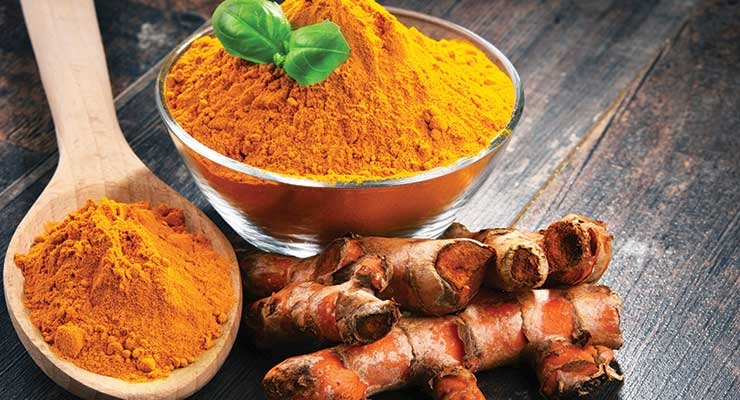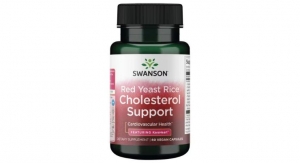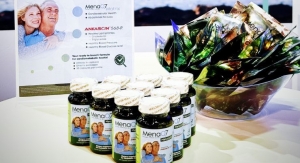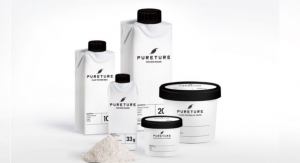By Nutraceuticals World Staff 05.02.19
The Indian spice turmeric, derived from the roots of Curcuma longa—a flowering plant of the ginger family (Zingiberaceae)—has undergone a meteoric rise in the nutraceutical marketplace in recent years, alongside its principal chemical constituent, curcumin, which gives turmeric its bright yellow color.
After thousands of years of traditional use in Ayurvedic medicine, a vast audience is now attuned to the benefits of turmeric/curcumin, and are seeking it out in supplements, snacks, teas, drinks, and more.
A recent report from the Council for Responsible Nutrition discussing the 2018 CRN Consumer Survey on Dietary Supplements called turmeric “one of the industry’s rising stars,” despite the fact that five years ago it wasn’t even part of the survey. Today, according to Brian Wommack, senior vice president, communications, for CRN, “it’s the second most popular supplement in the herbal/botanical category.”
Worldwide president of Sabinsa Corporation (East Windsor, NJ), Shaheen Majeed, said curcumin has become nearly ubiquitous in the marketplace. “Next time you’re in a group of people ask who is taking it and for what,” he suggested. “You’ll find out half the people there are taking curcumin for a range of different reasons: some for joint health, others for heart health, some for antioxidant properties, and others for inflammation, and some because their doctors told them to.”
This widespread use reflects significant market growth, and experts have forecasted a bright future ahead. Grand View Research predicted the global curcumin market will expand to $1.3 billion by 2024, registering a CAGR of 12.3% between 2018-2025. The research firm noted North America was the largest regional market for curcumin in 2016 with a revenue of $261.2 million thanks to rising demand for curcumin-based nutritional products.
The American Botanical Council’s HerbalGram Herb Market Report (2017) (citing SPINS/IRI data) found turmeric had the strongest growth in the U.S. mainstream channel from the previous year, earning roughly $32.5 million in sales. The ingredient was up five places from the previous year with a 46.7% growth rate. For the natural channel, turmeric earned the top spot among herbal ingredients with $50 million in sales, representing 12.2% growth.
Golden Opportunities
Based on the diverse and significant benefits of turmeric and curcumin, experts believe there’s tremendous potential to improve public health.
Brian Appell, marketing manager for Morristown NJ-based OmniActive Health Technologies suggested the most noteworthy demographics keen on curcumin were both millennials and baby boomers, “who are interested in performing at their best and staying active, respectively.” With these consumers “curcumin has a chance to shine,” because it assists healthy inflammatory response, a key consideration for performance and recovery. “Weave in its functionality across a wide range of product applications and you have a health ingredient that has great potential to serve a lot of different consumers at the right place, at the right time.”
Ingrid Rickers, research and development director for MegaFood, Manchester, NH, suggested that younger adults are using turmeric for antioxidant and recovery support, and those 50+ are “using turmeric for joint support and memory indications.”
Stacey Gillespie, director of product strategy for Gaia Herbs, Brevard, NC, indicated the core audience for turmeric are those in the 38-68 age range, “which is a time in life when aches and pains start appearing and there is generally a longer recovery time from physical activities.”
CRN’s 2018 Consumer Survey further corroborated older consumers’ interest; nearly 20% of U.S. adults aged 55 and up reported taking turmeric/curcumin supplements.
In 2018 the Global Curcumin Association conducted consumer research across several ingredient categories. Findings showed the typical curcumin user skews female (61% versus 55% of overall supplement users in the survey), has higher income, and is “slightly less ethnically diverse.” Consumer recognition and use of curcumin was high, according to Len Monheit, the organization’s executive director. “From both an actual usage standpoint, as well as those having ‘heard of it’ curcumin/turmeric scored high,” he explained. Curcumin/turmeric users were well-informed of its benefits, and were seeking its support for issues such as “pain/inflammation, joint health and for the product’s antioxidant properties,” noted Monheit.
Another factor captivating consumers is turmeric’s unique flavor profile and appearance. According to Innova Market Insight’s Top Ten Trends for 2019, consumers are seeking out “unexpected flavor blends,” “visual appeal,” and new flavor “discoveries,” particularly as globalization sparks consumer interest in new and authentic food and beverage experiences. Clearly, the taste, look, and story behind turmeric make this functional flavor a fan favorite.
“In food and beverage, consumers are craving more complex ‘earthy’ flavors, and bright, playful colors,” added Brian Zapp, creative director for Applied Food Sciences, Inc (AFS), Austin, TX. “The golden-yellow spice turmeric meets this demand offering brilliant color and a cultural flavor that will put a highlight on any beverage or snack food.”
Scientific Support
Modern science continues to validate traditional use, with new research indicating benefits of turmeric and curcumin for a wide range of health indications.
Sports & Fitness
A huge area of research surrounding curcumin and turmeric is exploring effects on inflammation, particularly related to sports performance and recovery.
A recent study conducted at the University of Queensland on Pharmako Biotechnologies’ HydroCurc bioavailable curcumin investigated its use for exercise recovery, specifically Delayed Onset Muscle Soreness (DOMS). In a randomized, double-blind, placebo-controlled clinical trial with a 72-hour treatment duration, participants who consumed HydroCurc had significantly lower pain at 48 hours post-exercise. Results suggested that a return to training may be possible earlier for those using HydroCurc than for those that consumed the placebo. “The blood markers for inflammation also showed HydroCurc reducing inflammation,” explained Eric Meppem, co-founder and commercial director for Australia-based Pharmako Biotechnologies (a partner of Gencor, Irvine, CA). “Less pain at a training session can lead to improved training adaptations, such as faster returns to training and subsequently improved exercise performance.”
Zapp with AFS pointed to the International Olympic Committee’s position on curcumin as validation of the ingredient’s safety and efficacy in the world of sports. He explained, “In its consensus statement on dietary supplements and high-performance athletes, the International Olympic Committee has listed curcumin as a possible supplement to aid in recovery due to its anti-inflammatory properties [British Journal of Sports Medicine, 2018].”
In addition, he said turmeric’s anti-inflammatory properties have encouraged many sports-related studies to investigate its ability to enhance recovery and reduce muscle damage following exercise. “Preliminary data suggests oral supplementation with turmeric can decrease muscle inflammation and decrease muscle related pain, as well as reduce the overall stress perceived by the athlete.”
Cardiovascular Health
OmniActive’s recent FloMeD (Flow Mediated Dilation) study demonstrated that taking 1,000 mg of its CurcuWin Curcumin increased flow mediated dilation—a measure of cardiovascular health—which correlates to a reduction in cardiovascular risk. “Not only do these findings show promise for the heart health category but also sports nutrition where a strong heart is an integral part of performance,” commented Appell.
The FloMeD study was a randomized, double-blind, placebo-controlled study in healthy subjects, which measured the impact of CurcuWIN on circulation. “Flow mediated dilation (FMD)—a process that measures the ability of blood vessels to dilate—is a useful tool because it is a sensitive and non-invasive process to evaluate the efficacy of natural ingredients for cardiovascular function,” noted Appell. The results showed that supplementing with 1,000 mg of CurcuWIN significantly improved FMD by 37% (Journal of Nutrition and Metabolism, 2016). “When compared to other studies on ergogenics purported to increase blood flow, such as arginine, CurcuWIN showed greater improvement in FMD at a lower dosage. The result is greater blood flow and nutrient availability to support performance.”
Zapp pointed to a randomized, double-blind, placebo-controlled trial published in The Journal of Nutritional Biochemistry (Chuengsamarn et al. 2014) that demonstrated the positive effects of curcuminoids for a significant reduction in pulse wave velocity (a measure of arterial stiffness) along with a significant decrease in markers of inflammation (increase in serum adiponectin and decrease in leptin). “The study also demonstrated significant decreases in insulin resistance, triglyceride, and uric acid levels,” he added.
Further support for triglyceride control was found in a randomized cross-over study (Mohammadi et al., Phytotherapy Research, 2013), that showed significant decrease in blood triglyceride levels when given 1 gram/day curcuminoids for a 30-day period.
“A 2016 study ... indicated that moderate consumption of curry correlated with a significant decrease in blood glucose and triglyceride levels for older males and younger, overweight females with high blood glucose and triglyceride levels [Nutrition Research and Practice, 2016],” added Zapp.
Diabetes
In a randomized, double-blind, placebo-controlled trial involving 100 subjects with type 2 diabetes, subjects received either a combination of Sabinsa’s Curcumin C3 Complex and BioPerine standardized black pepper extract (500 mg/5 mg, respectively, as daily dose) or placebo for three months. Researchers found the Curcumin C3 Complex and BioPerine combination improved glycemic parameters such as glucose concentration and Hb1Ac in the blood.
“Decrease in both these parameters indicated a positive response to Curcumin C3 Complex and BioPerine by diabetic subjects,” said Majeed. “Levels of C-peptide, which is an indicator of the amount of insulin produced, also registered an increase in the subjects receiving the combination over the placebo-receiving subjects. Hepatic health in the supplement-receiving subjects also improved as shown by the ALT and AST parameters. Additionally, improved function of the beta cells of the pancreas, the site of insulin production, was indicated by HOMA-β values measured.”
Researchers noted an increase in the values of anti-inflammatory adiponectin, an adipokine connected with glucose maintenance and insulin sensitivity. “This increase was observed along with a decreasing leptin/adiponectin ratio and lower values of leptin,” said Majeed. “The leptin/adiponectin ratio has been recognized as an indicator of atherosclerosis with lower values as a healthy indicator. The trial also indicated lower levels of pro-inflammatory cytokine TNFα in Curcumin C3 Complex and BioPerine group.”
In February 2019, a study published in Anticancer Research examined the effect of curcumin on proteins that stimulate insulin production. “The study showed the use of curcumin on the enzyme tyrosine phosphatase (PTP1B) had an inhibitory effect on the beta cells of the pancreas,” explained Shailinder Sodhi, president of Ayush Herbs, Redmond, WA, associate professor of Bastyr University. “It was shown that curcumin was able to inhibit (PTP1B), reducing stress on the pancreas. Though other studies show curcumin and its use in diabetes, this is a molecular study that shows a molecular change in beta cells. It begs the question, what other enzymatic changes are being made for those with diabetes?”
Wound Healing
Wound healing is seeing a surge in research, according to Sodhi. “A 2018 study [published in International Would Journal] showed that curcumin applied topically with fat healed laceration, puncture, and abrasion wounds more completely and with less scarring than controls,” he said. “This was verified macroscopically and microscopically. Collagen rebuilding was also more significant in the treatment group.”
Food Preservation
As a known antifungal and antibacterial, turmeric can play a vital role in ensuring the safety of food concerning microbial contamination. Zapp referenced a 2015 study published in the Journal of Food Science and Technology, which demonstrated the ability of turmeric extract to inhibit microbial growth. “Meals that were treated with a turmeric extract and autoclaved for five minutes were able to resist microbial growth as well as non-treated meals autoclaved for 15 minutes. Furthermore, the studies demonstrated the effectiveness of the extracts on inhibiting the growth of microbes, including Escherichia coli, Staphylococcus aureus, and Salmonella typhi.”
Challenges & Solutions
Despite manufacturers’ eagerness to incorporate turmeric and curcumin in nutritional products, these compounds are not easy to work with. Issues such as bioavailability, texture, solubility, and even harvesting concerns are all factors manufacturers must consider and control.
“Manufacturers of finished products are often overwhelmed by the available information, the variety of extracts and ingredients to choose from, and the challenges of disseminating and translating information for their consumers,” said Monheit of the Global Curcumin Association. “That’s where suppliers are able to and should be called upon to help.”
Charlotte Traas, director of sales education and training at New Chapter, Inc., Brattleboro, VT, discussed the intricacies of formulating with curcumin, which is a single active component in turmeric, versus the whole plant. “Curcumin is only 2-6% of the turmeric rhizome, and while it gets a lot of good publicity, many people may be missing out on the healing benefits of turmeric by only consuming the curcumin.”
She suggested the body’s difficulty in absorbing curcumin could be attenuated by consuming the whole plant. “Whole plant turmeric has many other beneficial constituents other than curcumin. Turmerones actually help curcumin to be absorbed and are naturally occurring within the turmeric rhizome. In fact, side effects that are experienced by taking high doses of curcumin only are usually toned down by taking, you guessed it, the whole plant.”
The time of year turmeric is harvested can also impact efficacy. “Turmeric root is most potent when harvested in the spring and summer seasons,” explained Sodhi of Ayush Herbs. “Many manufacturers acquire turmeric root during improper harvests and find themselves using more raw root for the different constituents desired.” He added that harvesting in the spring and summer can help make separating curcuminoids from other chemical components easier, thus benefiting ease of manufacture and providing a cost benefit.
While the bright yellow color of turmeric is appealing to consumers, the vibrant hue can pose problems when it comes to cleaning manufacturing equipment. “Working with turmeric in our operational facilities can be challenging as the ingredient easily stains to a bright orange/yellow color,” said Rickers of MegaFood.
Likewise, Gillespie of Gaia Herbs added, “turmeric easily stains everything it touches, which requires additional steps and more thorough cleaning processes on all equipment and facilities that come into contact with this herb.” Sabinsa’s Majeed also said the ingredient’s “vivid yellow color tends to stain machines and facility walls, increasing labor costs for extra cleaning.”
Zapp of AFS admitted some companies have refused to take on turmeric projects altogether because of its difficult cleanup. “Production runs involving traditional turmeric extracts can incur post-production clean times that are five to six times longer than when running other ingredients.”
To address the issue of the turmeric’s color, Sabinsa developed C3 Reduct ODN, a patented off-white color extract standardized to 95% tetrahydrocurcuminoids, that Majeed called “the next generation curcumin.” He said, “The C3 Reduct has advantages in manufacturing due to it being colorless (no staining) and because it’s all active metabolites, so a smaller dose gives the same benefits.”
Meanwhile, AFS offers CurcuFlow, a free-flowing curcumin extract, designed “to achieve a cleaner, stain-free turmeric production,” said Zapp. “The beadlet technology [CurcuFlow] does not adhere to machinery, resulting in post-production cleanup that is 90% more efficient.”
In addition to its color, the consistency of turmeric is even a challenge. “Due to turmeric extract’s fluffy consistency, supplement manufacturers find it has poor flow properties in manufacturing,” added Majeed.
To help address these issues, Sabinsa offers various grades of Curcumin C3 Complex, such as directly compressible (DC), high bulk density (HBD), and high granular particle (GP), for customers to use in their formulations. For the food and beverage industry, Sabinsa developed a water-soluble (WS) version of curcumin, called uC3 Clear.
According to Zapp, “one of the biggest challenges in working with turmeric in food and beverage is its lack of solubility.” While he called the process of micronizing the root and delivering flavor a simple task, the hydrophobic (water-hating) nature of curcuminoids means they tend to separate in a solution quickly. “Nothing deters consumers more than a bottle sitting on a shelf with a pile of sediment lining the bottom of the receptacle,” he stated.
AFS offers PurTurmeric, which targets the issue of solubility in beverages. “Turmeric contains hydrophobic molecules that are fat-soluble, so when it comes to beverage formulation, typical turmeric ingredients leave behind sedimentation, texture, or other undesired sensory profiles,” explained Zapp.
Poor solubility goes hand-in-hand with issues of bioavailability, explained Meppem of Pharmako Biotechnologies. “Curcumin is poorly absorbed, as the human gastrointestinal tract is an aqueous environment. Lipophilic active ingredients provide challenges from a formulation and bioavailability perspective,” he stated. “Often, improving bioavailability leads to decreased active load in final formulations. Many delivery systems for curcumin contain less than 20% curcuminoids.”
Pharmako Biotechnologies developed LipiSperse, which delivers 90% curcumin with a targeted dispersion technology that also benefits bioavailability. Meanwhile, HydroCurc, based on the LipiSperse dispersion technology, is a powder which can be used in ready-to-mix powders, effervescent powders and tablets, beverages, and gels.
Due to curcumin’s poor solubility and bioavailability, the dose of standard curcumin needed to achieve health benefits would be “staggering,” noted Appell of OmniActive, “and as we all know, consumers do not like having to take numerous, large pills—and this directly affects compliance.” To address both these issues OmniActive offers two formulation-flexible options with clinically demonstrated bioavailability over standard curcumin through its patented UltraSOL technology—CurcuWIN (46 times more bioavailable) and UltraSOL Curcumin (31 times more bioavailable). “UltraSOL enhances absorption of and protects curcuminoids, preserves curcuminoids for long-lasting action, and maintains the natural curcuminoid profile found in turmeric,” said Appell.
Naturex, Avignon, France, (now part of Givaudan) recently launched a new turmeric ingredient also targeting the issues of solubility and bioavailability. According to the company, a 300 mg dose of its Turmipure Gold delivers more curcuminoids in blood than 1,500 mg of standard turmeric (containing 95% curcuminoids) with or without black pepper extract. In addition to offering bioequivalence at a low dose, Turmipure Gold is also available as 100% organic certified grade. Alexis Manfré, global product manager for Naturex, said for consumers this means “efficacy at a low dose, and cost-effectiveness,” in a product that can be applied to convenient delivery formats such as shots, gummies, capsules, and instant beverages.
Adulteration & Safety Concerns
Unfortunately, when a trending ingredient creates significant buzz and offers the promise of financial gain, unscrupulous “bad actors” are often attracted to the industry. “Curcumin is a hot product, and when an herb is in high demand adulteration can occur,” explained Majeed of Sabinsa. “Some companies resort to unethical measures, including adulteration, to undercut competition by offering enticingly cheap products. Just as ethical companies develop innovative techniques to identify adulterants, those involved in adulteration are seeking ways to foil these techniques.”
He stressed that a concerted effort must be made by leading manufacturers to avoid these fraudulent suppliers, in order to keep the natural products industry “sustainable and credible.”
Majeed noted that Sabinsa identified a synthetic version of curcumin in the marketplace several years back, and alerted the industry and advised that radiocarbon testing was an effective tool to distinguish synthetic from natural curcumin. “Additionally, single entity synthetic curcumin is more crystalline in nature, thus less soluble. We test each batch of Curcumin C3 Complex in order to provide an assurance of its natural origin to customers.”
By law, manufacturers are required to conduct “fit for purpose” testing to confirm identity, he noted. “When a known adulterant is identified, companies should make testing to exclude its presence a priority.”
“Investing in testing and not relying solely on supplier data has become an industry must,” stressed Traas of New Chapter. “While it does cost more, it also assures that you are not getting adulterated (fake) products filled with chemical solvents. Companies who invest in testing are investing in quality and the reliability of the industry as a whole to give results customers want.”
Gillespie said Gaia Herbs is addressing the issue of adulteration “by consistently using the same trusted growers and suppliers that we have worked with for years. Our trusted partners are asked to follow organic and sustainable cultivation methods, which we validate through site visits and analytical testing of the raw materials themselves.”
In addition, Gaia Herbs has a rigorous testing process for all of its ingredients to ensure quality and authenticity, she said. First, the plants used in its herbal extracts must meet or exceed the company’s purity standards. “Crops are harvested at the peak of bioactivity, and relevant parts—such as seeds, flowers, leaves, stems, tubers, or rhizomes—must be delivered to our laboratory whole and intact in order to ensure that key bioactive constituents are preserved and that species validation can be verified in every shipment.”
Next, each batch of raw materials is quarantined upon arrival at Gaia Herb’s processing facility until they are inspected and analyzed to confirm identity, and ensure the plants have not been damaged during cultivation or shipping, Gillespie explained.
“Beyond visual and tactile inspection, tests are also conducted to ensure the absence of heavy metal toxicity, pesticides, and other chemical contaminants, as well as salmonella, E. coli, mold, yeast, and other microbial contaminants,” she added. “This is also the point where the first round of analytical testing is used to verify the levels of bioactive constituents.” If any batch of raw material fails to meet Gaia’s standards, it is immediately destroyed or discarded.
Last, the company offers a consumer outreach program to promote its supply chain transparency. “At Gaia Herbs, we believe that everyone should know the life story of all the herbal supplements they take. Through Meet Your Herbs, the world’s first herbal traceability program, you can enter the ID number located on the back of any Gaia Herbs product and discover the source of the ingredients, how the herbs were grown, harvested, and extracted; and the tests these ingredients underwent to validate their purity, integrity, and potency. Gaia Herbs is one of the few companies producing herbal supplements in the world that allows you to do this for a simple reason: Gaia has nothing to hide and everything to share.”
Industry trade organizations are also stepping up to help guide responsible parties in addressing this issue. “Suppliers, particularly members of the Global Curcumin Association, are very concerned regarding synthetic adulteration of curcumin and turmeric products,” noted Monheit. “This is a high priority to better understand how widespread this adulteration is and in which types of products. So far, we have conducted random testing of curcumin products purchased online and have found a disturbing level of adulteration as measured quantitatively by radioisotope testing at a commercial lab equipped for this purpose. FDA has indicated they are also worried about this. Our members too have been vocal, taking the stance of traceable, highly integrated, and captive supply chains, thus ensuring quality and efficacy and absolutely no adulteration. We are seeing more calls in the market for the addition of specifications and testing calling out the absence of synthetic curcumin.”
The Global Curcumin Association is contacting companies that have tested positive for adulterated products to request correction. “We are also trying to establish dialogue with e-tailers to discuss transparency strategies,” Monheit said.
Sonya Cropper, vice president of innovation and marketing of Indiana-based Verdure Sciences said manufacturers and suppliers of ingredients—especially those associated with the Global Curcumin Association—are diligently working to ensure that traceable, unadulterated ingredients are in the finished products consumers are seeking. “Not only have associations and their affiliated supporters made strides to ensure consistency and quality, but Verdure has an active botanical testing system, VBATS (Verdure Botanical Active Testing System), to align its ingredient solutions with strict quality parameters both in-house and through third parties.”
To certify the turmeric in AFS’ curcumin extracts, the company has developed a multistep approach which incorporates both United States Pharmacopeia (USP) and AOAC-validated methods for specific compound identification. In addition, “AFS then conducts isotope testing to ensure no synthetic substances have been introduced in the raw material,” noted Zapp. The company is also a member of the American Botanical Council (ABC) and supports “continued efforts to educate the industry.”
Meanwhile, OmniActive is one of the corporate sponsors of ABC’s Botanical Adulterants Prevention Program. “As part of the program ABC has come up with a report on building awareness of adulteration in turmeric extracts,” explained Appell. “We think this is a great initiative to build industry awareness.”
In addition, OmniActive has its own PlantActive Verification Program, which focuses on “comprehensive chain of custody and quality, ensures authenticity, purity, and consistency for all our products,” Appell said. “Our raw material comes from designated sources and we do seasonal species validation through DNA fingerprinting. We test the actives by HPLC analysis for three active components and identify isomers of curcumin against working standards. This is done to ensure the three curcuminoids from rhizome are appropriately used in CurcuWIN. We periodically conduct carbon dating analysis to validate that our product is natural and non-synthetic and the results are available on a requested basis.”
Lastly, the company’s CurcuWIN has undergone the USP verification process under the Dietary Ingredient Verification Program. “Our product value chain has been audited and verified by USP, and this ensures that our methods are validated and ensures consistency in the product.”
Sydney-based Pharmako Biotechnologies follows Australian cGMP standards, based upon European PICs (pharmaceutical) standards, according to Meppem. “As such, all batches are assayed by third-party external laboratories.” In addition, Meppem said HydroCurc is being used by international and professional athletes, which has made it necessary for those batches to be tested by NSF International.
Rickers of MegaFood believes both ingredient suppliers and product manufacturers have roles to play in ensuring purity and authenticity. “Suppliers should be doing more and more quality testing, identity testing, and stability studies of their raw materials. The same goes for responsible companies; they should be testing inbound lots of raw material, performing identity testing, and comparing their results to the results supplied by the raw material provider. Truly responsible companies will never just accept the raw materials supplier’s word and/or verification that the material they are buying is what they say it is. Instead, they will go the extra mile to do the testing and verification on their own to ensure the material they are using is what they want it to be.” MegaFood tests all of its finished products for 125+ herbicides and pesticides, as well as glyphosate residue.
Supplements, Snacks, Drinks, & More
Functional foods and beverages are emerging as a trending platform for turmeric and curcumin, as more consumers seek nutritional formulas they can seamlessly incorporate into their daily routines.
“Diversifying turmeric outside of just the supplement aisle is a new trend,” according to Rickers. One of the most notable new delivery methods for turmeric has been in the form of beverages such as drinks and teas, she said. To diversify its turmeric platform, MegaFood offers a traditional herbal supplement with turmeric, new Turmeric Inflammation Response Gummies, and Daily Turmeric Nutritional Boost Powder.
Market research firm Mintel pointed to the rise in “golden milk” beverages—a mixture of hot milk and turmeric, which is often infused with spices like pepper, cinnamon, and ginger. Recognizing its roots in Ayurvedic medicine, consumers are opting for golden milk for its bright yellow coloring and antioxidant potential, and for its ability to target inflammation and improve digestion. Mintel noted the drinks’ assent in Europe, particularly in Germany, which accounted for half (50%) of all golden milk/turmeric latte product launches in Europe between 2016 and May 2017.
Many finished product manufacturers are embracing delivery trends outside of the conventional capsule/tablet format, noted Appell. “A big player in the non-pill segment are gummies, which are expected to reach $4.17 billion by 2025 (Transparency Market Research, 2017). Vitamin Friends has developed a mango flavored vegan pectin gummy, which delivers 250 mg of CurcuWIN curcumin in just
one serving.”
Because of turmeric’s popularity and broad applications, Gaia Herb’s Gillespie said this herb can be found in a multitude of novel deliveries, including ice cream, gummies, chocolates, bone broths, and salad toppers. However, she noted that while many of these products are made with high-quality ingredients, they may not provide enough turmeric for health benefits or claims. “Adding culinary turmeric is beneficial and we do recommend including it in your diet. As a food, turmeric supports your ojas (vital energy), and, being a bitter herb, it supports
digestion, too.”
However, a supplemental extract can offer targeted health support, Gillespie said. “In herbal supplements, the trend that we are currently seeing with turmeric is the use of this herb in formulations that support cognitive and brain health. Research has shown there is a link in declining cognitive health and inflammation. Turmeric extract is included in supplements for the brain because of this herb’s ability to help maintain a healthy inflammatory response.”
Gaia Herbs recently developed a new line of nootropic supplements, including the product Agile Mind, which features turmeric. Made with bacopa, turmeric, and Ginkgo, the formula is designed to support healthy brain function and maintain healthy recall. “Agile Mind provides adaptogenic support to help your mind stay sharp. It is ideal for busy working professionals or anyone juggling multiple tasks,” said Gillespie.
For a supplement in a more conventional pill format, New Chapter offers Turmeric Force, from both a water and a supercritical extract, noted Trass. The formula offers consumers potency, the benefits of all the components of turmeric, and it has been tested for purity.
Projections & Predictions
As innovators develop new and interesting products, it seems the future will continue to look bright (gold) for turmeric and curcumin.
“We’re very confident in the future of this category,” said Monheit. “Research continues to emerge—much of it mechanistic—so we should see good claims support and consumer awareness.” However, he cautioned that with any growth category, the more popular the ingredient becomes the riper it is for exploitation and misleading information.
“With turmeric in the research limelight, it is most probable that people with a diverse set of conditions will be seeking its benefits,” said Sodhi of Ayush Herbs. He pointed to research surrounding musculoskeletal, respiratory, and autoimmune issues as areas of focus for future science and innovation. “As research grows, and that research is being conducted heavily, turmeric will continue to show safe and efficacious benefits.”
According to Appell of OmniActive, interest in—and the clinically demonstrated benefits of—curcuminoids will continue to fuel demand for high-quality formulas. However, the consumer landscape is changing. “We are seeing a shift in thinking from, ‘I want to reduce pain faster,’ or ‘I want to improve my mobility,’ to ‘I want to optimize my activities by keeping my health intact.’ As people are becoming more proactive rather than reactive with their health, we see a conversion from ‘health managers’ to ‘wellness managers.’ And the latter will drive the curcumin market to even greater heights.”
After thousands of years of traditional use in Ayurvedic medicine, a vast audience is now attuned to the benefits of turmeric/curcumin, and are seeking it out in supplements, snacks, teas, drinks, and more.
A recent report from the Council for Responsible Nutrition discussing the 2018 CRN Consumer Survey on Dietary Supplements called turmeric “one of the industry’s rising stars,” despite the fact that five years ago it wasn’t even part of the survey. Today, according to Brian Wommack, senior vice president, communications, for CRN, “it’s the second most popular supplement in the herbal/botanical category.”
Worldwide president of Sabinsa Corporation (East Windsor, NJ), Shaheen Majeed, said curcumin has become nearly ubiquitous in the marketplace. “Next time you’re in a group of people ask who is taking it and for what,” he suggested. “You’ll find out half the people there are taking curcumin for a range of different reasons: some for joint health, others for heart health, some for antioxidant properties, and others for inflammation, and some because their doctors told them to.”
This widespread use reflects significant market growth, and experts have forecasted a bright future ahead. Grand View Research predicted the global curcumin market will expand to $1.3 billion by 2024, registering a CAGR of 12.3% between 2018-2025. The research firm noted North America was the largest regional market for curcumin in 2016 with a revenue of $261.2 million thanks to rising demand for curcumin-based nutritional products.
The American Botanical Council’s HerbalGram Herb Market Report (2017) (citing SPINS/IRI data) found turmeric had the strongest growth in the U.S. mainstream channel from the previous year, earning roughly $32.5 million in sales. The ingredient was up five places from the previous year with a 46.7% growth rate. For the natural channel, turmeric earned the top spot among herbal ingredients with $50 million in sales, representing 12.2% growth.
Golden Opportunities
Based on the diverse and significant benefits of turmeric and curcumin, experts believe there’s tremendous potential to improve public health.
Brian Appell, marketing manager for Morristown NJ-based OmniActive Health Technologies suggested the most noteworthy demographics keen on curcumin were both millennials and baby boomers, “who are interested in performing at their best and staying active, respectively.” With these consumers “curcumin has a chance to shine,” because it assists healthy inflammatory response, a key consideration for performance and recovery. “Weave in its functionality across a wide range of product applications and you have a health ingredient that has great potential to serve a lot of different consumers at the right place, at the right time.”
Ingrid Rickers, research and development director for MegaFood, Manchester, NH, suggested that younger adults are using turmeric for antioxidant and recovery support, and those 50+ are “using turmeric for joint support and memory indications.”
Stacey Gillespie, director of product strategy for Gaia Herbs, Brevard, NC, indicated the core audience for turmeric are those in the 38-68 age range, “which is a time in life when aches and pains start appearing and there is generally a longer recovery time from physical activities.”
CRN’s 2018 Consumer Survey further corroborated older consumers’ interest; nearly 20% of U.S. adults aged 55 and up reported taking turmeric/curcumin supplements.
In 2018 the Global Curcumin Association conducted consumer research across several ingredient categories. Findings showed the typical curcumin user skews female (61% versus 55% of overall supplement users in the survey), has higher income, and is “slightly less ethnically diverse.” Consumer recognition and use of curcumin was high, according to Len Monheit, the organization’s executive director. “From both an actual usage standpoint, as well as those having ‘heard of it’ curcumin/turmeric scored high,” he explained. Curcumin/turmeric users were well-informed of its benefits, and were seeking its support for issues such as “pain/inflammation, joint health and for the product’s antioxidant properties,” noted Monheit.
Another factor captivating consumers is turmeric’s unique flavor profile and appearance. According to Innova Market Insight’s Top Ten Trends for 2019, consumers are seeking out “unexpected flavor blends,” “visual appeal,” and new flavor “discoveries,” particularly as globalization sparks consumer interest in new and authentic food and beverage experiences. Clearly, the taste, look, and story behind turmeric make this functional flavor a fan favorite.
“In food and beverage, consumers are craving more complex ‘earthy’ flavors, and bright, playful colors,” added Brian Zapp, creative director for Applied Food Sciences, Inc (AFS), Austin, TX. “The golden-yellow spice turmeric meets this demand offering brilliant color and a cultural flavor that will put a highlight on any beverage or snack food.”
Scientific Support
Modern science continues to validate traditional use, with new research indicating benefits of turmeric and curcumin for a wide range of health indications.
Sports & Fitness
A huge area of research surrounding curcumin and turmeric is exploring effects on inflammation, particularly related to sports performance and recovery.
A recent study conducted at the University of Queensland on Pharmako Biotechnologies’ HydroCurc bioavailable curcumin investigated its use for exercise recovery, specifically Delayed Onset Muscle Soreness (DOMS). In a randomized, double-blind, placebo-controlled clinical trial with a 72-hour treatment duration, participants who consumed HydroCurc had significantly lower pain at 48 hours post-exercise. Results suggested that a return to training may be possible earlier for those using HydroCurc than for those that consumed the placebo. “The blood markers for inflammation also showed HydroCurc reducing inflammation,” explained Eric Meppem, co-founder and commercial director for Australia-based Pharmako Biotechnologies (a partner of Gencor, Irvine, CA). “Less pain at a training session can lead to improved training adaptations, such as faster returns to training and subsequently improved exercise performance.”
Zapp with AFS pointed to the International Olympic Committee’s position on curcumin as validation of the ingredient’s safety and efficacy in the world of sports. He explained, “In its consensus statement on dietary supplements and high-performance athletes, the International Olympic Committee has listed curcumin as a possible supplement to aid in recovery due to its anti-inflammatory properties [British Journal of Sports Medicine, 2018].”
In addition, he said turmeric’s anti-inflammatory properties have encouraged many sports-related studies to investigate its ability to enhance recovery and reduce muscle damage following exercise. “Preliminary data suggests oral supplementation with turmeric can decrease muscle inflammation and decrease muscle related pain, as well as reduce the overall stress perceived by the athlete.”
Cardiovascular Health
OmniActive’s recent FloMeD (Flow Mediated Dilation) study demonstrated that taking 1,000 mg of its CurcuWin Curcumin increased flow mediated dilation—a measure of cardiovascular health—which correlates to a reduction in cardiovascular risk. “Not only do these findings show promise for the heart health category but also sports nutrition where a strong heart is an integral part of performance,” commented Appell.
The FloMeD study was a randomized, double-blind, placebo-controlled study in healthy subjects, which measured the impact of CurcuWIN on circulation. “Flow mediated dilation (FMD)—a process that measures the ability of blood vessels to dilate—is a useful tool because it is a sensitive and non-invasive process to evaluate the efficacy of natural ingredients for cardiovascular function,” noted Appell. The results showed that supplementing with 1,000 mg of CurcuWIN significantly improved FMD by 37% (Journal of Nutrition and Metabolism, 2016). “When compared to other studies on ergogenics purported to increase blood flow, such as arginine, CurcuWIN showed greater improvement in FMD at a lower dosage. The result is greater blood flow and nutrient availability to support performance.”
Zapp pointed to a randomized, double-blind, placebo-controlled trial published in The Journal of Nutritional Biochemistry (Chuengsamarn et al. 2014) that demonstrated the positive effects of curcuminoids for a significant reduction in pulse wave velocity (a measure of arterial stiffness) along with a significant decrease in markers of inflammation (increase in serum adiponectin and decrease in leptin). “The study also demonstrated significant decreases in insulin resistance, triglyceride, and uric acid levels,” he added.
Further support for triglyceride control was found in a randomized cross-over study (Mohammadi et al., Phytotherapy Research, 2013), that showed significant decrease in blood triglyceride levels when given 1 gram/day curcuminoids for a 30-day period.
“A 2016 study ... indicated that moderate consumption of curry correlated with a significant decrease in blood glucose and triglyceride levels for older males and younger, overweight females with high blood glucose and triglyceride levels [Nutrition Research and Practice, 2016],” added Zapp.
Diabetes
In a randomized, double-blind, placebo-controlled trial involving 100 subjects with type 2 diabetes, subjects received either a combination of Sabinsa’s Curcumin C3 Complex and BioPerine standardized black pepper extract (500 mg/5 mg, respectively, as daily dose) or placebo for three months. Researchers found the Curcumin C3 Complex and BioPerine combination improved glycemic parameters such as glucose concentration and Hb1Ac in the blood.
“Decrease in both these parameters indicated a positive response to Curcumin C3 Complex and BioPerine by diabetic subjects,” said Majeed. “Levels of C-peptide, which is an indicator of the amount of insulin produced, also registered an increase in the subjects receiving the combination over the placebo-receiving subjects. Hepatic health in the supplement-receiving subjects also improved as shown by the ALT and AST parameters. Additionally, improved function of the beta cells of the pancreas, the site of insulin production, was indicated by HOMA-β values measured.”
Researchers noted an increase in the values of anti-inflammatory adiponectin, an adipokine connected with glucose maintenance and insulin sensitivity. “This increase was observed along with a decreasing leptin/adiponectin ratio and lower values of leptin,” said Majeed. “The leptin/adiponectin ratio has been recognized as an indicator of atherosclerosis with lower values as a healthy indicator. The trial also indicated lower levels of pro-inflammatory cytokine TNFα in Curcumin C3 Complex and BioPerine group.”
In February 2019, a study published in Anticancer Research examined the effect of curcumin on proteins that stimulate insulin production. “The study showed the use of curcumin on the enzyme tyrosine phosphatase (PTP1B) had an inhibitory effect on the beta cells of the pancreas,” explained Shailinder Sodhi, president of Ayush Herbs, Redmond, WA, associate professor of Bastyr University. “It was shown that curcumin was able to inhibit (PTP1B), reducing stress on the pancreas. Though other studies show curcumin and its use in diabetes, this is a molecular study that shows a molecular change in beta cells. It begs the question, what other enzymatic changes are being made for those with diabetes?”
Wound Healing
Wound healing is seeing a surge in research, according to Sodhi. “A 2018 study [published in International Would Journal] showed that curcumin applied topically with fat healed laceration, puncture, and abrasion wounds more completely and with less scarring than controls,” he said. “This was verified macroscopically and microscopically. Collagen rebuilding was also more significant in the treatment group.”
Food Preservation
As a known antifungal and antibacterial, turmeric can play a vital role in ensuring the safety of food concerning microbial contamination. Zapp referenced a 2015 study published in the Journal of Food Science and Technology, which demonstrated the ability of turmeric extract to inhibit microbial growth. “Meals that were treated with a turmeric extract and autoclaved for five minutes were able to resist microbial growth as well as non-treated meals autoclaved for 15 minutes. Furthermore, the studies demonstrated the effectiveness of the extracts on inhibiting the growth of microbes, including Escherichia coli, Staphylococcus aureus, and Salmonella typhi.”
Challenges & Solutions
Despite manufacturers’ eagerness to incorporate turmeric and curcumin in nutritional products, these compounds are not easy to work with. Issues such as bioavailability, texture, solubility, and even harvesting concerns are all factors manufacturers must consider and control.
“Manufacturers of finished products are often overwhelmed by the available information, the variety of extracts and ingredients to choose from, and the challenges of disseminating and translating information for their consumers,” said Monheit of the Global Curcumin Association. “That’s where suppliers are able to and should be called upon to help.”
Charlotte Traas, director of sales education and training at New Chapter, Inc., Brattleboro, VT, discussed the intricacies of formulating with curcumin, which is a single active component in turmeric, versus the whole plant. “Curcumin is only 2-6% of the turmeric rhizome, and while it gets a lot of good publicity, many people may be missing out on the healing benefits of turmeric by only consuming the curcumin.”
She suggested the body’s difficulty in absorbing curcumin could be attenuated by consuming the whole plant. “Whole plant turmeric has many other beneficial constituents other than curcumin. Turmerones actually help curcumin to be absorbed and are naturally occurring within the turmeric rhizome. In fact, side effects that are experienced by taking high doses of curcumin only are usually toned down by taking, you guessed it, the whole plant.”
The time of year turmeric is harvested can also impact efficacy. “Turmeric root is most potent when harvested in the spring and summer seasons,” explained Sodhi of Ayush Herbs. “Many manufacturers acquire turmeric root during improper harvests and find themselves using more raw root for the different constituents desired.” He added that harvesting in the spring and summer can help make separating curcuminoids from other chemical components easier, thus benefiting ease of manufacture and providing a cost benefit.
While the bright yellow color of turmeric is appealing to consumers, the vibrant hue can pose problems when it comes to cleaning manufacturing equipment. “Working with turmeric in our operational facilities can be challenging as the ingredient easily stains to a bright orange/yellow color,” said Rickers of MegaFood.
Likewise, Gillespie of Gaia Herbs added, “turmeric easily stains everything it touches, which requires additional steps and more thorough cleaning processes on all equipment and facilities that come into contact with this herb.” Sabinsa’s Majeed also said the ingredient’s “vivid yellow color tends to stain machines and facility walls, increasing labor costs for extra cleaning.”
Zapp of AFS admitted some companies have refused to take on turmeric projects altogether because of its difficult cleanup. “Production runs involving traditional turmeric extracts can incur post-production clean times that are five to six times longer than when running other ingredients.”
To address the issue of the turmeric’s color, Sabinsa developed C3 Reduct ODN, a patented off-white color extract standardized to 95% tetrahydrocurcuminoids, that Majeed called “the next generation curcumin.” He said, “The C3 Reduct has advantages in manufacturing due to it being colorless (no staining) and because it’s all active metabolites, so a smaller dose gives the same benefits.”
Meanwhile, AFS offers CurcuFlow, a free-flowing curcumin extract, designed “to achieve a cleaner, stain-free turmeric production,” said Zapp. “The beadlet technology [CurcuFlow] does not adhere to machinery, resulting in post-production cleanup that is 90% more efficient.”
In addition to its color, the consistency of turmeric is even a challenge. “Due to turmeric extract’s fluffy consistency, supplement manufacturers find it has poor flow properties in manufacturing,” added Majeed.
To help address these issues, Sabinsa offers various grades of Curcumin C3 Complex, such as directly compressible (DC), high bulk density (HBD), and high granular particle (GP), for customers to use in their formulations. For the food and beverage industry, Sabinsa developed a water-soluble (WS) version of curcumin, called uC3 Clear.
According to Zapp, “one of the biggest challenges in working with turmeric in food and beverage is its lack of solubility.” While he called the process of micronizing the root and delivering flavor a simple task, the hydrophobic (water-hating) nature of curcuminoids means they tend to separate in a solution quickly. “Nothing deters consumers more than a bottle sitting on a shelf with a pile of sediment lining the bottom of the receptacle,” he stated.
AFS offers PurTurmeric, which targets the issue of solubility in beverages. “Turmeric contains hydrophobic molecules that are fat-soluble, so when it comes to beverage formulation, typical turmeric ingredients leave behind sedimentation, texture, or other undesired sensory profiles,” explained Zapp.
Poor solubility goes hand-in-hand with issues of bioavailability, explained Meppem of Pharmako Biotechnologies. “Curcumin is poorly absorbed, as the human gastrointestinal tract is an aqueous environment. Lipophilic active ingredients provide challenges from a formulation and bioavailability perspective,” he stated. “Often, improving bioavailability leads to decreased active load in final formulations. Many delivery systems for curcumin contain less than 20% curcuminoids.”
Pharmako Biotechnologies developed LipiSperse, which delivers 90% curcumin with a targeted dispersion technology that also benefits bioavailability. Meanwhile, HydroCurc, based on the LipiSperse dispersion technology, is a powder which can be used in ready-to-mix powders, effervescent powders and tablets, beverages, and gels.
Due to curcumin’s poor solubility and bioavailability, the dose of standard curcumin needed to achieve health benefits would be “staggering,” noted Appell of OmniActive, “and as we all know, consumers do not like having to take numerous, large pills—and this directly affects compliance.” To address both these issues OmniActive offers two formulation-flexible options with clinically demonstrated bioavailability over standard curcumin through its patented UltraSOL technology—CurcuWIN (46 times more bioavailable) and UltraSOL Curcumin (31 times more bioavailable). “UltraSOL enhances absorption of and protects curcuminoids, preserves curcuminoids for long-lasting action, and maintains the natural curcuminoid profile found in turmeric,” said Appell.
Naturex, Avignon, France, (now part of Givaudan) recently launched a new turmeric ingredient also targeting the issues of solubility and bioavailability. According to the company, a 300 mg dose of its Turmipure Gold delivers more curcuminoids in blood than 1,500 mg of standard turmeric (containing 95% curcuminoids) with or without black pepper extract. In addition to offering bioequivalence at a low dose, Turmipure Gold is also available as 100% organic certified grade. Alexis Manfré, global product manager for Naturex, said for consumers this means “efficacy at a low dose, and cost-effectiveness,” in a product that can be applied to convenient delivery formats such as shots, gummies, capsules, and instant beverages.
Adulteration & Safety Concerns
Unfortunately, when a trending ingredient creates significant buzz and offers the promise of financial gain, unscrupulous “bad actors” are often attracted to the industry. “Curcumin is a hot product, and when an herb is in high demand adulteration can occur,” explained Majeed of Sabinsa. “Some companies resort to unethical measures, including adulteration, to undercut competition by offering enticingly cheap products. Just as ethical companies develop innovative techniques to identify adulterants, those involved in adulteration are seeking ways to foil these techniques.”
He stressed that a concerted effort must be made by leading manufacturers to avoid these fraudulent suppliers, in order to keep the natural products industry “sustainable and credible.”
Majeed noted that Sabinsa identified a synthetic version of curcumin in the marketplace several years back, and alerted the industry and advised that radiocarbon testing was an effective tool to distinguish synthetic from natural curcumin. “Additionally, single entity synthetic curcumin is more crystalline in nature, thus less soluble. We test each batch of Curcumin C3 Complex in order to provide an assurance of its natural origin to customers.”
By law, manufacturers are required to conduct “fit for purpose” testing to confirm identity, he noted. “When a known adulterant is identified, companies should make testing to exclude its presence a priority.”
“Investing in testing and not relying solely on supplier data has become an industry must,” stressed Traas of New Chapter. “While it does cost more, it also assures that you are not getting adulterated (fake) products filled with chemical solvents. Companies who invest in testing are investing in quality and the reliability of the industry as a whole to give results customers want.”
Gillespie said Gaia Herbs is addressing the issue of adulteration “by consistently using the same trusted growers and suppliers that we have worked with for years. Our trusted partners are asked to follow organic and sustainable cultivation methods, which we validate through site visits and analytical testing of the raw materials themselves.”
In addition, Gaia Herbs has a rigorous testing process for all of its ingredients to ensure quality and authenticity, she said. First, the plants used in its herbal extracts must meet or exceed the company’s purity standards. “Crops are harvested at the peak of bioactivity, and relevant parts—such as seeds, flowers, leaves, stems, tubers, or rhizomes—must be delivered to our laboratory whole and intact in order to ensure that key bioactive constituents are preserved and that species validation can be verified in every shipment.”
Next, each batch of raw materials is quarantined upon arrival at Gaia Herb’s processing facility until they are inspected and analyzed to confirm identity, and ensure the plants have not been damaged during cultivation or shipping, Gillespie explained.
“Beyond visual and tactile inspection, tests are also conducted to ensure the absence of heavy metal toxicity, pesticides, and other chemical contaminants, as well as salmonella, E. coli, mold, yeast, and other microbial contaminants,” she added. “This is also the point where the first round of analytical testing is used to verify the levels of bioactive constituents.” If any batch of raw material fails to meet Gaia’s standards, it is immediately destroyed or discarded.
Last, the company offers a consumer outreach program to promote its supply chain transparency. “At Gaia Herbs, we believe that everyone should know the life story of all the herbal supplements they take. Through Meet Your Herbs, the world’s first herbal traceability program, you can enter the ID number located on the back of any Gaia Herbs product and discover the source of the ingredients, how the herbs were grown, harvested, and extracted; and the tests these ingredients underwent to validate their purity, integrity, and potency. Gaia Herbs is one of the few companies producing herbal supplements in the world that allows you to do this for a simple reason: Gaia has nothing to hide and everything to share.”
Industry trade organizations are also stepping up to help guide responsible parties in addressing this issue. “Suppliers, particularly members of the Global Curcumin Association, are very concerned regarding synthetic adulteration of curcumin and turmeric products,” noted Monheit. “This is a high priority to better understand how widespread this adulteration is and in which types of products. So far, we have conducted random testing of curcumin products purchased online and have found a disturbing level of adulteration as measured quantitatively by radioisotope testing at a commercial lab equipped for this purpose. FDA has indicated they are also worried about this. Our members too have been vocal, taking the stance of traceable, highly integrated, and captive supply chains, thus ensuring quality and efficacy and absolutely no adulteration. We are seeing more calls in the market for the addition of specifications and testing calling out the absence of synthetic curcumin.”
The Global Curcumin Association is contacting companies that have tested positive for adulterated products to request correction. “We are also trying to establish dialogue with e-tailers to discuss transparency strategies,” Monheit said.
Sonya Cropper, vice president of innovation and marketing of Indiana-based Verdure Sciences said manufacturers and suppliers of ingredients—especially those associated with the Global Curcumin Association—are diligently working to ensure that traceable, unadulterated ingredients are in the finished products consumers are seeking. “Not only have associations and their affiliated supporters made strides to ensure consistency and quality, but Verdure has an active botanical testing system, VBATS (Verdure Botanical Active Testing System), to align its ingredient solutions with strict quality parameters both in-house and through third parties.”
To certify the turmeric in AFS’ curcumin extracts, the company has developed a multistep approach which incorporates both United States Pharmacopeia (USP) and AOAC-validated methods for specific compound identification. In addition, “AFS then conducts isotope testing to ensure no synthetic substances have been introduced in the raw material,” noted Zapp. The company is also a member of the American Botanical Council (ABC) and supports “continued efforts to educate the industry.”
Meanwhile, OmniActive is one of the corporate sponsors of ABC’s Botanical Adulterants Prevention Program. “As part of the program ABC has come up with a report on building awareness of adulteration in turmeric extracts,” explained Appell. “We think this is a great initiative to build industry awareness.”
In addition, OmniActive has its own PlantActive Verification Program, which focuses on “comprehensive chain of custody and quality, ensures authenticity, purity, and consistency for all our products,” Appell said. “Our raw material comes from designated sources and we do seasonal species validation through DNA fingerprinting. We test the actives by HPLC analysis for three active components and identify isomers of curcumin against working standards. This is done to ensure the three curcuminoids from rhizome are appropriately used in CurcuWIN. We periodically conduct carbon dating analysis to validate that our product is natural and non-synthetic and the results are available on a requested basis.”
Lastly, the company’s CurcuWIN has undergone the USP verification process under the Dietary Ingredient Verification Program. “Our product value chain has been audited and verified by USP, and this ensures that our methods are validated and ensures consistency in the product.”
Sydney-based Pharmako Biotechnologies follows Australian cGMP standards, based upon European PICs (pharmaceutical) standards, according to Meppem. “As such, all batches are assayed by third-party external laboratories.” In addition, Meppem said HydroCurc is being used by international and professional athletes, which has made it necessary for those batches to be tested by NSF International.
Rickers of MegaFood believes both ingredient suppliers and product manufacturers have roles to play in ensuring purity and authenticity. “Suppliers should be doing more and more quality testing, identity testing, and stability studies of their raw materials. The same goes for responsible companies; they should be testing inbound lots of raw material, performing identity testing, and comparing their results to the results supplied by the raw material provider. Truly responsible companies will never just accept the raw materials supplier’s word and/or verification that the material they are buying is what they say it is. Instead, they will go the extra mile to do the testing and verification on their own to ensure the material they are using is what they want it to be.” MegaFood tests all of its finished products for 125+ herbicides and pesticides, as well as glyphosate residue.
Supplements, Snacks, Drinks, & More
Functional foods and beverages are emerging as a trending platform for turmeric and curcumin, as more consumers seek nutritional formulas they can seamlessly incorporate into their daily routines.
“Diversifying turmeric outside of just the supplement aisle is a new trend,” according to Rickers. One of the most notable new delivery methods for turmeric has been in the form of beverages such as drinks and teas, she said. To diversify its turmeric platform, MegaFood offers a traditional herbal supplement with turmeric, new Turmeric Inflammation Response Gummies, and Daily Turmeric Nutritional Boost Powder.
Market research firm Mintel pointed to the rise in “golden milk” beverages—a mixture of hot milk and turmeric, which is often infused with spices like pepper, cinnamon, and ginger. Recognizing its roots in Ayurvedic medicine, consumers are opting for golden milk for its bright yellow coloring and antioxidant potential, and for its ability to target inflammation and improve digestion. Mintel noted the drinks’ assent in Europe, particularly in Germany, which accounted for half (50%) of all golden milk/turmeric latte product launches in Europe between 2016 and May 2017.
Many finished product manufacturers are embracing delivery trends outside of the conventional capsule/tablet format, noted Appell. “A big player in the non-pill segment are gummies, which are expected to reach $4.17 billion by 2025 (Transparency Market Research, 2017). Vitamin Friends has developed a mango flavored vegan pectin gummy, which delivers 250 mg of CurcuWIN curcumin in just
one serving.”
Because of turmeric’s popularity and broad applications, Gaia Herb’s Gillespie said this herb can be found in a multitude of novel deliveries, including ice cream, gummies, chocolates, bone broths, and salad toppers. However, she noted that while many of these products are made with high-quality ingredients, they may not provide enough turmeric for health benefits or claims. “Adding culinary turmeric is beneficial and we do recommend including it in your diet. As a food, turmeric supports your ojas (vital energy), and, being a bitter herb, it supports
digestion, too.”
However, a supplemental extract can offer targeted health support, Gillespie said. “In herbal supplements, the trend that we are currently seeing with turmeric is the use of this herb in formulations that support cognitive and brain health. Research has shown there is a link in declining cognitive health and inflammation. Turmeric extract is included in supplements for the brain because of this herb’s ability to help maintain a healthy inflammatory response.”
Gaia Herbs recently developed a new line of nootropic supplements, including the product Agile Mind, which features turmeric. Made with bacopa, turmeric, and Ginkgo, the formula is designed to support healthy brain function and maintain healthy recall. “Agile Mind provides adaptogenic support to help your mind stay sharp. It is ideal for busy working professionals or anyone juggling multiple tasks,” said Gillespie.
For a supplement in a more conventional pill format, New Chapter offers Turmeric Force, from both a water and a supercritical extract, noted Trass. The formula offers consumers potency, the benefits of all the components of turmeric, and it has been tested for purity.
Projections & Predictions
As innovators develop new and interesting products, it seems the future will continue to look bright (gold) for turmeric and curcumin.
“We’re very confident in the future of this category,” said Monheit. “Research continues to emerge—much of it mechanistic—so we should see good claims support and consumer awareness.” However, he cautioned that with any growth category, the more popular the ingredient becomes the riper it is for exploitation and misleading information.
“With turmeric in the research limelight, it is most probable that people with a diverse set of conditions will be seeking its benefits,” said Sodhi of Ayush Herbs. He pointed to research surrounding musculoskeletal, respiratory, and autoimmune issues as areas of focus for future science and innovation. “As research grows, and that research is being conducted heavily, turmeric will continue to show safe and efficacious benefits.”
According to Appell of OmniActive, interest in—and the clinically demonstrated benefits of—curcuminoids will continue to fuel demand for high-quality formulas. However, the consumer landscape is changing. “We are seeing a shift in thinking from, ‘I want to reduce pain faster,’ or ‘I want to improve my mobility,’ to ‘I want to optimize my activities by keeping my health intact.’ As people are becoming more proactive rather than reactive with their health, we see a conversion from ‘health managers’ to ‘wellness managers.’ And the latter will drive the curcumin market to even greater heights.”



























